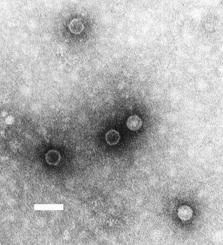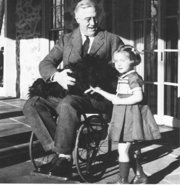Poliomyelitis
Poliomyelitis ("polio"), or infantile paralysis, is a viral paralytic disease. The causative agent, a virus called poliovirus (PV), enters the body orally, infecting the intestinal wall. It may proceed to the blood stream and into the central nervous system causing muscle weakness and often paralysis. more...
Eradication efforts led by the World Health Organization have reduced the number of annual diagnosed cases from the hundreds of thousands to around a thousand.
Infection
Polio (infantile paralysis) is a communicable disease which is categorized as a disease of civilization. Polio spreads through human-to-human contact, usually entering the body through the mouth due to fecally contaminated water or food. The poliovirus is a small RNA (ribonucleic acid) virus that has three different strains and is extremely infectious. The virus invades the nervous system, and the onset of paralysis can occur in a matter of hours. While polio can strike a person at any age, over fifty percent of the cases occurred to children between the ages of three and five. The incubation period of polio, from the time of first exposure to first symptoms, ranges from three to thirty five days.
Polio can spread widely before physicians detect the first signs of a polio outbreak. Surprisingly, most people infected with the poliovirus have no symptoms or outward signs of the illness and are thus never aware they have been infected. After the person is exposed to the poliovirus, the virus is expelled through faeces for several weeks and it is during this time that a polio outbreak can occur in a community. The three strains of poliovirus result in non-paralytic polio, paralytic polio, and bulbar polio. In all forms of polio, the early symptoms of infection are fatigue, fever, vomiting, headache and pain in the neck and extremities.
Types of polio
Non-paralytic polio
Non-paralytic polio will result in fever, vomiting, abdominal pain, lethargy, and irritability. Some muscle spasms in the neck and back, with muscles generally tender to the touch.
Spinal paralytic polio
This strain of the poliovirus attacks the spinal column where it destroys the anterior horn cells which control movement of the trunk and limb muscles. Although this strain of the poliovirus can lead to permanent paralysis, less than one in two hundred with symptoms will result in paralysis. The most common paralysis will affect the legs. Once the poliovirus invades the intestines, it is absorbed by the capillaries in the walls of the intestine and is then carried by the bloodstream throughout the body. The poliovirus attacks the spinal column and the motor neurons—which control physical movement. It is during this period of infection that flu-like symptoms occur; however, for people who have no immunity or have not been vaccinated, the virus usually goes on to infect the entire spinal column and the brain stem. This infection affects the central nervous system (CNS)—spreading along nerve fibers. As the virus continues to multiply in the CNS, the virus destroys motor neurons. Motor neurons do not regenerate and any affected muscles will no longer respond to CNS commands. The most common paralysis occurs to the muscles of the legs. The result is that the limb becomes floppy and lifeless—a condition known as acute flaccid paralysis (AFP). An extreme infection of the CNS can cause extensive paralysis of the trunk and muscles of the thorax and abdomen (quadriplegia).
Read more at Wikipedia.org




